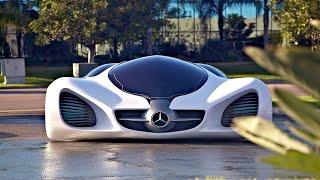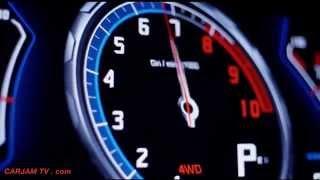1982 CHEVROLET CAMARO.
The third-generation Chevrolet Camaro is an American pony car which was introduced for the 1982 model year by Chevrolet. It continued to use General Motors' F-body platform and produced a "20th Anniversary Commemorative Edition" for 1987 and "25th Anniversary Heritage Edition" for 1992. These were also the first Camaros with factory fuel injection, four-speed automatic transmissions, five-speed manual transmissions, four-cylinder engines, 16-inch wheels, and hatchback bodies. For 1987 a convertible Camaro was reintroduced, converted by ASC in relatively small numbers. The third-generation Camaro continued through the 1992 model year.
The Camaro's design owed nothing to previous generations. The large and complex rear window reflected recent advances in car glass design. The front windshield reclined at 62 degrees, thus breaking an internal GM rule limiting such angles to sixty degrees. The rear seat folded down to expand the luggage compartment, which was accessed through a large rear hatch.
1982
The Third-Generation Camaro was released for sale in December, 1981, beginning production on October 12, 1981. The 1982 model introduced the first Camaros with a hatchback body style, and such options as factory fuel injection, and a four-cylinder engine.
The Camaro Z28 was Motor Trend magazine's Car of the Year for 1982. Three models were available: Sport Coupe, Berlinetta, and Z28. 173,000 Camaros were sold in the United States in 1982. 12 percent of buyers took the four-cylinder, 37 percent the V6, while 51 percent opted for the V8.
The Sport Coupe came standard with the 2.5L (151 ci) LQ9 four-cylinder engine. The 2.8L (173 ci) LC1 V6 and the 5.0L (305 ci) LG4 V8 were optional. Dog dish-style hubcaps were standard; full wheel covers were optional as were steel, five-spoke 14x7-inch body-colored rally wheels.
The Berlinetta came with the standard 2.8 LC1 V6 or the optional 5.0 LG4 V8. This package also sported unique 14x7-inch finned aluminum wheel with gold accenting and a 'Berlinetta' center cap. Its own lower body pin striping, gold 'Berlinetta' badging, and headlamp pockets were painted in an accent color. The taillights got a gold and black horizontal divider bar. The interior came standard with custom cloth interior, a rear storage well cover and additional carpeting on rear wheelhouses. It also came standard with additional body insulation and full instrumentation.
The Z28 came standard with the 5.0L LG4 4-bbl V8 rated at 145hp (108kW) and was available with either a four-speed manual or three-speed 350 lockup automatic transmission. The optional LU5 twin TBI 'Cross Fire Injection' 5.0L (305 ci) with functioning hood scoops was rated at 165hp (123kW) and was only available with an automatic transmission. The new Camaro received positive reviews for its styling and handling, but was also criticized for the low power ratings for the Camaro Z28.
The Z28s included lightweight fiberglass SMC hoods with functional hood air induction flaps on RPO LU5 cars. The Z28 had a different nose, a three-piece rear spoiler and front, side, and rear lower body valances in silver or gold. Just above the valance was a three-color lower body stripe that encircled the car. Headlamp pockets on the Z28 were black. Standard were new 15x7-inch cast-aluminum five-spoke wheels accented with silver or gold. Z28 badges appeared on the right rear bumper and on the side valances. On early models, if the "Conteur" sport seats were selected as an option, the passenger seat was purposefully a mismatched high-back bucket seat design, due to production shortages of the passenger seat.
The Camaro Z28 was the pace car for the 1982 Indianapolis 500 race, and over 6,000 appearance replicas were sold through Chevrolet dealers. The edition featured special two-tone silver/blue paint and special striping, orange pin-striping on 15-inch (380 mm) Z28 wheels, and a silver/blue interior with six-way Lear-Seigler manually adjustable seating. Engine choices in the pace cars were the same as the regular production Z28. The car that actually paced the event was equipped with a highly-modified, all-aluminum 5.7 L V8 that was not available on the replica cars.
At the 1982 Geneva Motor Show, a special European specification version was shown, the Camaro Z28E. The "E" stood for "Export" and it received British National Type Approval in 1982.[13] The Z28E received the 157 PS (155 hp; 115 kW) DIN carburetted 5-liter V8, while the 108 PS (107 hp; 79 kW) 2.8-liter V6 was soon added to the lineup.
CC rating: 4,998cc 305 ci (5.0L) Chev V8
NZ First Registration: 22-Dec-2005
The third-generation Chevrolet Camaro is an American pony car which was introduced for the 1982 model year by Chevrolet. It continued to use General Motors' F-body platform and produced a "20th Anniversary Commemorative Edition" for 1987 and "25th Anniversary Heritage Edition" for 1992. These were also the first Camaros with factory fuel injection, four-speed automatic transmissions, five-speed manual transmissions, four-cylinder engines, 16-inch wheels, and hatchback bodies. For 1987 a convertible Camaro was reintroduced, converted by ASC in relatively small numbers. The third-generation Camaro continued through the 1992 model year.
The Camaro's design owed nothing to previous generations. The large and complex rear window reflected recent advances in car glass design. The front windshield reclined at 62 degrees, thus breaking an internal GM rule limiting such angles to sixty degrees. The rear seat folded down to expand the luggage compartment, which was accessed through a large rear hatch.
1982
The Third-Generation Camaro was released for sale in December, 1981, beginning production on October 12, 1981. The 1982 model introduced the first Camaros with a hatchback body style, and such options as factory fuel injection, and a four-cylinder engine.
The Camaro Z28 was Motor Trend magazine's Car of the Year for 1982. Three models were available: Sport Coupe, Berlinetta, and Z28. 173,000 Camaros were sold in the United States in 1982. 12 percent of buyers took the four-cylinder, 37 percent the V6, while 51 percent opted for the V8.
The Sport Coupe came standard with the 2.5L (151 ci) LQ9 four-cylinder engine. The 2.8L (173 ci) LC1 V6 and the 5.0L (305 ci) LG4 V8 were optional. Dog dish-style hubcaps were standard; full wheel covers were optional as were steel, five-spoke 14x7-inch body-colored rally wheels.
The Berlinetta came with the standard 2.8 LC1 V6 or the optional 5.0 LG4 V8. This package also sported unique 14x7-inch finned aluminum wheel with gold accenting and a 'Berlinetta' center cap. Its own lower body pin striping, gold 'Berlinetta' badging, and headlamp pockets were painted in an accent color. The taillights got a gold and black horizontal divider bar. The interior came standard with custom cloth interior, a rear storage well cover and additional carpeting on rear wheelhouses. It also came standard with additional body insulation and full instrumentation.
The Z28 came standard with the 5.0L LG4 4-bbl V8 rated at 145hp (108kW) and was available with either a four-speed manual or three-speed 350 lockup automatic transmission. The optional LU5 twin TBI 'Cross Fire Injection' 5.0L (305 ci) with functioning hood scoops was rated at 165hp (123kW) and was only available with an automatic transmission. The new Camaro received positive reviews for its styling and handling, but was also criticized for the low power ratings for the Camaro Z28.
The Z28s included lightweight fiberglass SMC hoods with functional hood air induction flaps on RPO LU5 cars. The Z28 had a different nose, a three-piece rear spoiler and front, side, and rear lower body valances in silver or gold. Just above the valance was a three-color lower body stripe that encircled the car. Headlamp pockets on the Z28 were black. Standard were new 15x7-inch cast-aluminum five-spoke wheels accented with silver or gold. Z28 badges appeared on the right rear bumper and on the side valances. On early models, if the "Conteur" sport seats were selected as an option, the passenger seat was purposefully a mismatched high-back bucket seat design, due to production shortages of the passenger seat.
The Camaro Z28 was the pace car for the 1982 Indianapolis 500 race, and over 6,000 appearance replicas were sold through Chevrolet dealers. The edition featured special two-tone silver/blue paint and special striping, orange pin-striping on 15-inch (380 mm) Z28 wheels, and a silver/blue interior with six-way Lear-Seigler manually adjustable seating. Engine choices in the pace cars were the same as the regular production Z28. The car that actually paced the event was equipped with a highly-modified, all-aluminum 5.7 L V8 that was not available on the replica cars.
At the 1982 Geneva Motor Show, a special European specification version was shown, the Camaro Z28E. The "E" stood for "Export" and it received British National Type Approval in 1982.[13] The Z28E received the 157 PS (155 hp; 115 kW) DIN carburetted 5-liter V8, while the 108 PS (107 hp; 79 kW) 2.8-liter V6 was soon added to the lineup.
CC rating: 4,998cc 305 ci (5.0L) Chev V8
NZ First Registration: 22-Dec-2005
- Category
- Autos & Vehicles













Comments